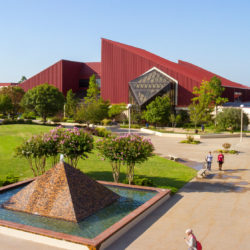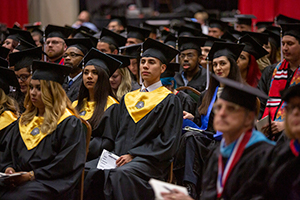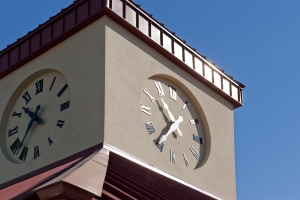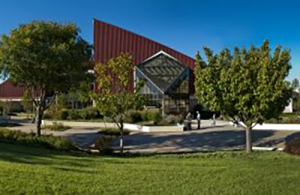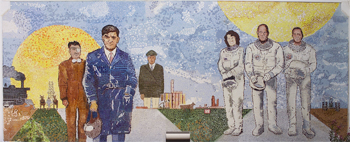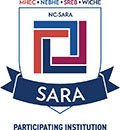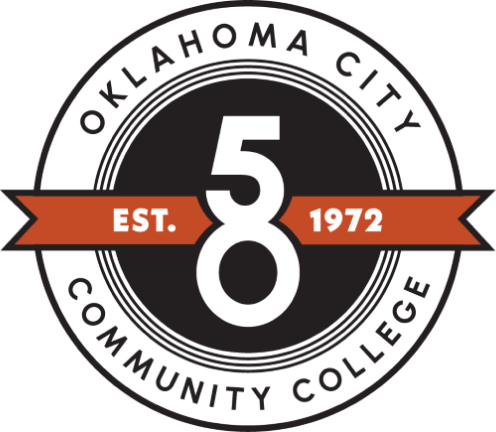Mosaics Aerospace Oklahoma
Aerospace Oklahoma
Click on panel for more detail
WILEY POST
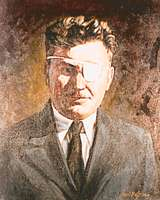
1898 - 1935
Fint To Fly Solo Around The World, 1933
Inducted in 1967
Wiley Hardeman Post, Aviator, Fourth Son Of William Francis And Mae (Quinlan) Post, Was Born Near Grand Saline In Van Zandt County, Texas, On November 22, 1898. Before his death in a plane crash in 1935, post became one of the best-known fliers in the world, mainly because of a flight around the world with navigator Harold Gatty in 1931 and a similar solo flight in 1933. In addition, he was known for his pioneer work in high altitude flight, particularly his role in developing an early pressure suit. His achievements in early aviation, more than two decades before the establishment of a United States space program, earned him a reputation as a pioneer in space flight. The airplane in which he made such contributions is today displayed at the national air and space museum in Washington, D.C., along with his pressure suit. Born a few years before the advent of manned flight, post spent his early years in northeast Texas before his farm family moved west and settled near Abilene in Taylor County in 1902. Around 1907 the family moved to southwestern Oklahoma. Although post lived outside the state the rest of his life, he traveled and worked in Texas while in the employ of Oklahoma oilmen and later married a Texas woman.
Post had little interest in farm work or school. He received an elementary education and later took a seven-month course at the Sweeney auto school in Kansas City, Missouri. He saw his first airplane at a county fair near Lawton, Oklahoma, in 1913 and quickly determined that he wanted to fly. He later turned to oilfield work in Oklahoma and began to dabble in "barnstorming" soon after the end of world war i,qv first as a parachute-jumper and later, after a few lessons, as a pilot. Thus began a career that would later carry him into the annals of aviation history. Eager to acquire his own airplane, post returned to oilfield work to earn the necessary funds, but he was injured while working near Seminole, Oklahoma, on October 1, 1926. A roughneck struck an iron bolt with a sledgehammer and a chip from the bolt lodged in Post's left eye. When infection set in, the eye has to be removed. He later received about $1,700 in workman's compensation. He continued to barnstorm in a plane bought with the proceeds, and, while on a tour of Texas, met Mae Laine of Sweetwater. They eloped in his plane on June 27, 1927, and were married in Oklahoma. No children resulted from this marriage. Sometime after his marriage, post wrecked his plane and was unable to afford repairs. Now in need of steady employment, post became a private pilot for oilmen Powell Briscoe and f. C. Hall, flying an open-cockpit travel-air biplane. He later acquired a pilot's license (number 3259) from the aeronautics branch of the United States department of commerce after flying a probationary period of about 700 hours. His physical handicap thus proved no barrier. Hall later gained an interest in the colorful world of aviation so aptly portrayed by Lindbergh's famous flight to Paris in 1927. In 1928 hall acquired a Lockheed Vega aircraft, which he named after his daughter, Winnie Mae. In 1930 hall bought a new Lockheed Vega also named Winnie Mae. It was this plane, made of plywood and designated 105w, that later made post famous. He would fly it around the world twice and later into the stratosphere.
Post's first venture into high visibility aviation came in 1930 when he won the air derby between Los Angeles and Chicago, a special event of the 1930 national air races. After consulting with Harold Gatty about a flight plan, he completed the flight in a little more than nine hours, achieving an average speed of nearly 200 miles per hour. The feat earned post $7,500 and national recognition.
His next flight would bring even more accolades. This time he hoped to complete a flight around the world-a distance of more than 15,596 miles in the northern latitudes in which he chose to travel. The route took post, accompanied again by Gatty, from New York to Newfoundland, England, and Germany, and then across Russia to Alaska (via Siberia) and back to New York City.
Ex-barnstormer Post and navigator Harold Gatty had thrilled the nation by dashing around the world in the "Winnie Mae". They departed on June 23, 1931, and returned on July 1, covering the distance in eight days, fifteen hours, and fifty-one minutes. For over one hundred and six hours, neither post nor Gatty had an opportunity to sleep. The flight's elapsed time of eight days, fifteen hours and fifty-one minutes far surpassed the previous record of twenty-one days set in 1929 by the airship "Graf Zeppelin." The pair later recounted their experience in around the world in eight days: the flight of the Winnie Mae, (1931) a ghost-written account with an introduction by will Rogers. Aviation magazine, a leading spokesman for the aviation industry, ranked the flight as a superlative achievement, comparable to Lindbergh's. Following a flurry of post-flight activity, post fell out with hall and bought the Winnie Mae. He subsequently made plans to circle the earth again, this time alone.
Despite the bad economic conditions that prevailed in the early 1930s, he raised the necessary funds and began the time-consuming process of planning the flight. He would follow basically the same route, but this time he would make fewer stops. Innovations included the use of a variable pitch propeller, an automatic direction-finder radio, and an automatic pilot furnished by the Sperry Gyroscope Company. Such equipment led the new York times to note: "he will ride around the world on radio waves while the robot flies the plane." post completed the flight in mid-July 1933, spanning the route in less than eight days, beating his earlier time by more than twenty-one hours, and becoming the first solo flyer to circle the earth. Post later turned to high-altitude experiments, sponsored by frank Phillips of the Phillips petroleum company. With the aid of engineers from the b. F. Goodrich Company, he designed and built a pressure suit that would allow him to fly as high as 50,000 feet. The Winnie Mae underwent several innovations, including the use of a super-charger. Although post made several flights into the stratosphere and later attempted to break the cross-country speed record, he was plagued by mechanical failures. Nevertheless, his achievements later earned him the reputation as the discoverer of the jet streams. His 1933 flight had won him the coveted Harmon international trophy, a feat shared with Lindbergh, Igor Skiers, and James Doolittle.
Between July 15 and 22, 1933, Wiley post made the first successful solo flight around the world in an airplane named the "Winnie Mae". The single engine Lockheed Vega was equipped with a Sperry automatic pilot, a radio direction finder, and other new devices. The flight covered 15,596 miles in seven days, eighteen hours forty-nine minutes and was perhaps the most remarkable display of flying endurance of the decade.
Post was considered one of the most colorful figures of early aviation. He set many records before being tragically killed near point barrow, Alaska on august 15, 1935 in a crash which also took the life of his flying companion, humorist Will Rogers. He was buried in memorial park cemetery in Edmond, Oklahoma. After post's death his widow sold the famed Winnie Mae to the Smithsonian. His accomplishments are still recognized by aviation experts. His aerial achievements proved that shrinking the globe was as much a test of human endurance as a display of technological progress.
The men had been killed while attempting to take off from a tidal lagoon near barrow. Wiley post, one of the most famous aviators in the world at the time, was flying the bright red Lockheed Orion Sirius explorer on floats. Most experts now believe that a combination of miscalculations in the design and operation of the heavily customized aircraft resulted in the uncontrollable spin that occurred right after takeoff.
